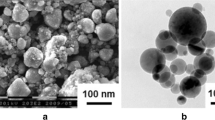Abstract
An alternate synthetic route has been described for the production of aluminum nanoparticles (Al-NPs). These Al-NPs were obtained through a reduction of aluminum acetylacetonate [Al(acac)3] by lithium aluminum hydride (LiAlH4) in mestitylene at 165 °C. The side products were removed by repeated washing with dry, ice cold methanol and the reaction mixture was filtered to obtain gray-colored Al-NPs. The synthesized nanoparticles were characterized by Powder X-ray diffraction pattern and 27Al-MAS-NMR spectrum. The X-ray diffraction pattern confirmed the formation of face-centered cubic (fcc) form of aluminum. The size and morphology were investigated by scanning electron microscope and transmission electron microscope which showed particle of varying shapes with size ranging from 50 to 250 nm. The weight loss from the nanoparticles was studied by thermo gravimetric analysis which indicated that the nanoparticles were tightly bound with an unknown amorphous organic residue which cannot be removed by simple washing. The carbonaceous residue might be outcome of the decomposition of acac ligand which was responsible in stabilizing aluminum nanoparticles.












Similar content being viewed by others
References
Arora N, Jagirdar BR (2012) Monodispersity and stability: case of ultrafine aluminum nanoparticles (<5 nm) synthesized by the solvated metal atom dispersion approach. J Mater Chem 22:9058–9063
Aumann CE, Skrofronick GL, Martin JA (1995) Oxidation behavior of aluminum nano particles. J Vac Sci Technol B 13:1178–1183
Bunker CE, Smith MJ, Fernando KAS, Harruff BA, Lewis WK, Gord JR, Guliants EA, Phelps DK (2010) Spontaneous hydrogen generation from organic: capped aluminum nanoparticles and water. ACS Appl Mater Interfaces 2:11–14
Chung SW, Guliants EA, Bunker CE, Hammerstroem DW, Deng Y, Burgers MA, Jelliss PA, Buckner SW (2009) Capping and passivation of aluminum nanoparticles using alkyl-substituted epoxides. Langmuir 25:8883–8887
Cooper PW (1996) Explosives engineering. Wiley, New York
Fernando SKA, Smith MJ, Harruff BA, Lewis WK, Guliants EA, Bunker CE (2009) Sonochemically assisted thermal decomposition of Alane N,N-dimethylethylamine with titanium (IV) isopropoxide in the presence of oleic acid to yield air-stable and size-selective aluminum core-shell nanoparticles. J Phys Chem C 113:500–503
Foley TJ, Johnson CE, Higa KT (2005) Inhibition of oxide formation on aluminum nanoparticles by transition metal coating. Chem Mater 17:4086–4091
Ghanta SR, Muralidharan K (2010) Solution phase chemical synthesis of aluminum nano particles stabilized in poly(vinylpyrollidone) poly methylmethacrylate matrices. Nanoscale 2:976–980
Haber JA, Buhro WE (1998) Kinetic instability of nanocrystalline aluminum prepared by chemical synthesis; facile room temperature grain growth. J Am Chem Soc 120:10847–10855
Hammerstroem DW, Burgers MA, Chung SW, Guliants EA, Bunker CE, Wentz KM, Hayes SE, Buckner SW, Jelliss PA (2011) Aluminum nanoparticles capped by polymerization of alkyl-substituted epoxides: ratio-dependent stability and particle size. Inorg Chem 50:5054–5059
Helmich RJ, Suslick KS (2010) Chemical aerosol flow synthesis of hollow metallic aluminum particles. Chem Mater 22:4835–4837
Holley CE Jr, Huber EJ Jr (1951) The heats of combustion of magnesium and aluminum. J Am Chem Soc 73:5577–5579
Jouet RJ, Warren AD, Rosenberg DM, Bellitto VJ, Park K, Zachariah MR (2005) Surface passivation of bare aluminum nano particles using perflouroalkyl carboxylic acids. Chem Mater 17:2987–2996
Leonard BM, Zhou Q, Wu D, Disalvo FJ (2011) Facile synthesis of PtNi intermetallic nanoparticles: influence of reducing agent and precursors on electro catalytic activity. Chem Mater 23:1136–1146
Li H, Meziani MJ, Lu F, Bunker CE, Guliants EA, Sun Y (2009) Templated synthesis of aluminum nanoparticles: a new route to stable energetic materials. J Phys Chem C 113:20539–20542
Mahendiran C, Ganesan R, Gedanken A (2009) Sonoelectrochemical synthesis of aluminum nano particles. Eur J Inorg Chem 14:2050–2053
Pomfret MB, Brown DJ, Epshteyn A, Purdy AP, Owrutsky JC (2008) Electrochemical deposition aluminum nano rods using ionic liquids. Chem Mater 20:5945–5947
Sadezky A, Muckenhuber H, Grothe H, Niessner R, Pöschl U (2005) Raman microspectroscopy of soot and related carbonaceous materials: spectral analysis and structural information. Carbon 43:1731–1742
Smith ME (1993) Application of 27Al NMR techniques to structure determination in solids. Appl Magn Reson 4:1–64
Trunov MA, Schoenitz M, Zhu X, Dreizin EL (2005) Effect of polymorphic phase transformations in Al2O3 film on oxidation kinetics of aluminum powders. Combust Flame 140:310–318
Acknowledgments
The authors gratefully acknowledge the funding from DRDO, India in the form of research Grant to ACRHEM and also thank the School of Chemistry, University of Hyderabad for the infrastructure and other instrument facilities.
Author information
Authors and Affiliations
Corresponding author
Rights and permissions
About this article
Cite this article
Ghanta, S.R., Muralidharan, K. Chemical synthesis of aluminum nanoparticles. J Nanopart Res 15, 1715 (2013). https://doi.org/10.1007/s11051-013-1715-1
Received:
Accepted:
Published:
DOI: https://doi.org/10.1007/s11051-013-1715-1




